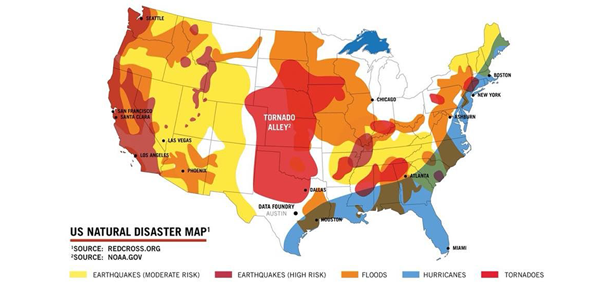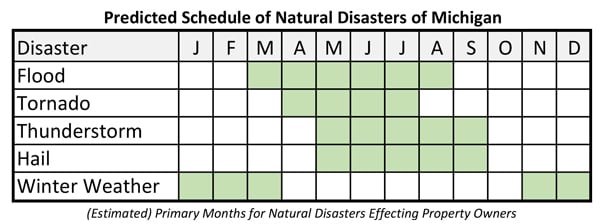Property owners of Michigan, this map, credited to redcross.org1, suggests that Michigan has insignificant threat of any natural disaster compared to all the rest of the states. Sure, we aren’t much effected by earthquakes, although we have felt aftershocks from time to time, and it’s unlikely that we will ever have hurricane force winds hit us, but the rain and lesser significant winds of hurricanes do reach us causing damage. Though someone looking at the map may pat themselves on the back for choosing to live in the Great State of Michigan, there are definitely natural disasters and other mayhem for which we need to be prepared.
 According to michigan.gov2, Michigan’s primary natural threats include floods, thunderstorms, tornadoes, wild fires, and of course winter weather. Knowing a few details and statistics can help us prepare for disasters, even though most disasters are completely unpredictable.
According to michigan.gov2, Michigan’s primary natural threats include floods, thunderstorms, tornadoes, wild fires, and of course winter weather. Knowing a few details and statistics can help us prepare for disasters, even though most disasters are completely unpredictable.
Thunderstorms are the “primary source of summer rainfall” in Michigan according to (weather-us.com)3. They are a heavy hitter possibly bringing heavy rain, flash flooding, wind, hail, tornadoes, and/or lightning. Each of these hazards bring their own havoc to property, which we will discuss more below. They occur mostly from May to September. Michigan averages 28 – 40 thunderstorms per year in the Lower Peninsula and 20 – 30 in the Upper Peninsula (michigan.gov)2. Building owners also have to be prepared for power outages during these storms.
Ninety percent of damage caused by natural disasters in the US is from a flood event (iii.org)4. There is not a “flooding season” per say, but they historically have happened in the spring and summer in Michigan. Additionally, Michigan’s potential for early spring flooding is higher because of the thawing of winter ice and snow makes lake and river levels rise. Floods cause damage to foundations, drywall and contents within a building, and if not cleaned or dried properly can result in microbial growth that makes inhabitants sick.
In Michigan, most tornadoes occur between April and July. Experts have even predicted that a tornado is more likely to occur between 3PM and 7PM. An average of 16 tornadoes occur in Michigan each year (michigan.gov)5. Tornadoes can cause massive damage to property through heavy winds and force. Depending on the strength of the wind a tornado can break heavy branches or uproot trees that land on a building, push mobile homes off their foundation, tear off roofs, level well-constructed walls, or lift homes off their foundation. Power outages are prevalent during tornado storms due to tree limbs and debris falling on power lines.
Hail is common in the spring season in Michigan (weather-us.com)3. Most Michigan counties see an average of 2 hail events per year. Hail can cause costly property damage to roofs and siding, resulting in insurance claims and restoration construction.
Wild fires have happened historically between March and October, and most commonly “during the driest part of the year”. More than 75% of Michigan is covered in forested land in Northern Lower Peninsula and Upper Peninsula. We see an average of 550 minor wild fire events a year (michigan.gov)2. Most people think that lightning is the main cause of the fires, but it is actually more commonly caused by debris burning. The Michigan.gov document “MHA 2019 Full Update Natural Hazards” discusses creating a vulnerable structure to be “Firewise” to protect it from wildfires, which includes non-flammable exterior materials and removing vegetation surrounding the building to provide a barrier from wildfire flames and ash.
Winter weather is more hazardous to automobiles and the health of individuals driving or walking/recreating in Michigan. However, our winter weather causes damage to property through ice dams, frozen pipes and heavy snow on roofs. The Lower Peninsula averages 90-180 days of below freezing temperatures (michigan.gov)2. Insulating pipes near outer walls and keeping the heat above 55 can help prevent the pipes from freezing. Flooding from frozen pipes only occurs once the pipe starts to thaw creating quite a mess causing restoration of your pipes and the water damage remediated. Ventilating your attic will help regulate the temperature and moisture in the space to prevent ice dams and water infiltration at the roof barrier. And flatter roof styles will need to remove snow built up on their shingles to protect from the weight, ice, thaw, and damage.
 The unpredictable behavior of Mother Nature makes it difficult to prepare your structure in some cases and still live daily life, so it’s most important to have a plan to protect yourself and have phone numbers ready to call your insurance provider and restoration contractor immediately after. It’s a good practice to have needed items ready in case the power goes out, for example: a light source, charged energy source(s), communication device(s), food, drink, and important papers in a safe place. Call Wolgast Restoration when a disaster hits your property.
The unpredictable behavior of Mother Nature makes it difficult to prepare your structure in some cases and still live daily life, so it’s most important to have a plan to protect yourself and have phone numbers ready to call your insurance provider and restoration contractor immediately after. It’s a good practice to have needed items ready in case the power goes out, for example: a light source, charged energy source(s), communication device(s), food, drink, and important papers in a safe place. Call Wolgast Restoration when a disaster hits your property.
Sources:
2 https://www.michigan.gov/documents/msp/MHA_2019__full_update_natural_hazards_653708_7.pdf
3 https://www.weather-us.com/en/michigan-usa-climate?f,in,in,mi#climate_text_4
4 https://www.iii.org/article/facts-about-flood-insurance
5 https://www.michigan.gov/documents/msp-tornado_tips_8781_7.pdf



 The storm has passed. No one was hurt. However, the house wasn’t so lucky. “Now what do we do?”
The storm has passed. No one was hurt. However, the house wasn’t so lucky. “Now what do we do?”  some snow. With our varying weather and temperatures, we are at a high risk of getting ice dams. Below are some reasons and solutions to stop Ice Dams before they start.
some snow. With our varying weather and temperatures, we are at a high risk of getting ice dams. Below are some reasons and solutions to stop Ice Dams before they start.